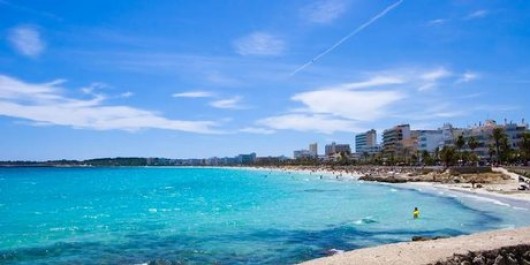Mallorca, the largest of Spain’s Balearic islands, is still a green place in the autumn, with sunshine comparable to that in more northern places in Europe.
However, the sea does sometimes show its rougher side, and on the beaches the red warning flags – “bathing forbidden” – may be seen and it might suddenly start to rain heavily.
That’s when holidaymakers will flee to their hotels and the beach will become deserted. For those who are not turned off by this, then they are visiting at just the right time.
The Mediterranean Sea around Mallorca is still around 24C in September, and even in October is only one or maybe two degrees cooler.
On sunny days, the beaches don’t look all that different from how they do in the summer, even on the eastern coast far from the island’s capital of Palma.
There, the most important tourism centre is Cala Millor. Along the promenade there is a row of benches and in the afternoons, elderly Spaniards regularly meet there to sit and watch the surf.
Down on the beach, many children are hurling themselves on their air mattresses into the water and letting themselves be washed back up on shore.
These are the final weeks of Mallorca’s main tourism season. Often, more visitors from a country like, for example, Germany will be counted in Mallorca in September than in June or August.
Then, when schools in northern Europe have autumn holidays, there is one more final spurt in the main tourism centres.
At the end of October, many hotels will then start shutting down, and soon afterwards the weather turns cool and uncomfortable. Then Mallorca – the island of lovers – takes a break from its mass tourism.
But even in early autumn the Mediterranean sometimes crashes heavily onto the eastern coast. When the wind blows more strongly, then holidaymakers are treated to quite a show by the waves as they pound the coastline at Cala Millor.
A few people might even venture to the edge of the cliffs, in order to feel the fine spray as the waves break onto the rocks and send plumes of water shooting several metres upwards.
The “wave-watchers” can be seen taking pictures or making brief video clips of the spectacle with their mobile phones. On such days the beach cots are stacked up high at Cala Millor.
There can be no thought given to going in the water. The skies are grey and the temperatures are as cool as in northern Europe in autumn.
Cala Millor is not comparable with Palma which draws so many of the German mass-tourism crowd. But it does mainly attract Britons and Germans, including those who in the evenings gladly drink a beer, or two, or three.
The pubs along the main strip have German or British-context names, like Zur Zapfsaeule (at the petrol pump) or Liverpool Pub. The beer is served in pint glasses and some places also serve a ‘Full English Breakfast’.
For hikers, by contrast, the peninsula Punta de n’Amer, located south of Cala Millor, is a favourite destination.
Sandy footpaths lead to the small-scale 17th-century fortress Castell de n’Amer which offers a fantastic view of the bay of Cala Millor.
Beyond this, there are a whole lot of places on the eastern coast, between Cap Formentor in the north and Cap Salines in the south, which are worth exploring. For example Portocolom, which nestles up to its harbour.
A bit further north, there’s Porto Cristo, a popular destination which can also be reached from Cala Millor in a glass-bottomed ship.
As in Portocolom there is no shortage of cafes and restaurants, many of them with a view of the yachts in the harbour.
Many visitors will proceed directly on to Coves del Drac – the dragons’ caves. Back in the Middle Ages, the system of caverns served as a hideout for the Majorcans against raiding pirates.
At one point, 40 metres below the ground, there’s the Lago Martel, a lake about 200 metres long, 175 metres of which visitors can explore by boat. Such flowstone caves are not unusual for the eastern part of Mallorca. The Coves del Hams are only a few kilometres away, and a bit further north there are the Coves d’Arta.
“Entrance to Hell” is the name given to the formation of stalactites and stalagmites which resemble a kind of gateway.
“Heaven” by contrast is a 40-metre-high chamber. One of the stalagmite columns, which grows in size by one centimetre per century, is 22-metres-tall. Just another 5000 years or so, and it will reach the chamber ceiling.
Source : nzherald.co.nz
By Andreas Heimann


